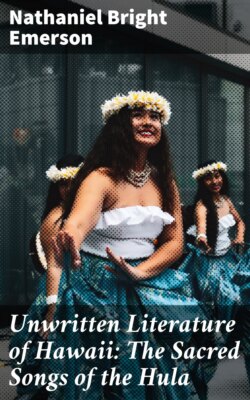Читать книгу Unwritten Literature of Hawaii: The Sacred Songs of the Hula - Nathaniel Bright Emerson - Страница 14
На сайте Литреса книга снята с продажи.
[Translation]
ОглавлениеAltar-Prayer to Laka
This spoil and rape of the wildwood,
This plucking of wilderness maile--
Collect of garlands, Laka, for you.
Hiiaka, the prophet, heals our diseases.
5
Enter, possess, inspire your altar;
Heed our prayer, 'tis for life;
Our petition to you is for life.
Chorus:
Give us life, save from transgression!
Footnote 15:(return) Hoo-ulu. This word has a considerable range of meaning, well illustrated in this mele. In its simplest form, ulu, it means to grow, to become strong. Joined with the causative hoo, as here, it takes on the spiritual meaning of causing to prosper, of inspiring. The word "collect," used in the translation, has been chosen to express the double sense of gathering the garlands and of devoting them to the goddess as a religious offering. In the fourth verse this word, hooulu, is used in the sense of to heal. Compare note c.
Footnote 16:(return) Hiiaka. The youngest sister of Pele, often spoken of as Hiiaka-i-ka-poli-o-Pele, Hiiaka-of-the-bosom-of-Pele. Why she should be spoken of as capable of healing diseases is not at all clear.
Footnote 17:(return) Ulu. Here we have the word ulu in its simple, uncombined form, meaning to enter into and inspire.
The wildwoods of Hawaii furnished in great abundance and variety small poles for the framework of the kuahu, the altar, the holy place of the halau, and sweet-scented leaves and flowers suitable for its decoration. A spirit of fitness, however, limited choice among these to certain species that were deemed acceptable to the goddess because they were reckoned as among her favorite forms of metamorphosis. To go outside this ordained and traditional range would have been an offense, a sacrilege. This critical spirit would have looked with the greatest disfavor on the practice that in modern times has crept in, of bedecking the dancers with garlands of roses, pinks, jessamine, and other nonindigenous flowers, as being utterly repugnant to the traditional spirit of the hula.
Among decorations approved and most highly esteemed stood pre-eminent the fragrant maile (pl. IV) and the star-like fronds and ruddy drupe of the íe-íe (pl. II) and its kindred, the hála-pépe (pl. III); the scarlet pompons of the lehúa (pl. XIII) and ohi'a, with the fruit of the latter (the mountain-apple); many varieties of fern, including that splendid parasite, the "bird's nest fern" (ekáha), hailed by the Hawaiians as Mawi's paddle; to which must be added the commoner leaves and lemon-colored flowers of the native hibiscus, the hau, the breadfruit, the native banana and the dracæna (ti), plate V; and lastly, richest of all, in the color that became Hawaii's favorite, the royal yellow ilíma (pl. VI), a flower familiar to the eyes of the tourist to Honolulu.
While deft hands are building and weaving the light framework of the kuahu, binding its parts with strong vines and decorating it with nature's sumptuous embroidery, the kumu, or teacher, under the inspiration of the deity, for whose residence he has prepared himself by long vigil and fasting with fleshly abstinence, having spent the previous night alone in the halau, is chanting or cantillating his adulatory prayers, kanaenae--songs of praise they seem to be--to the glorification of the gods and goddesses who are invited to bless the occasion with their presence and inspiration, but especially of that one, Laka, whose bodily presence is symbolized by a rude block of wood arrayed in yellow tapa that is set up on the altar itself. Thus does the kumu sing:
Pule Kuahu
El' au e Laka mai uka,
E Laka mai kai;
O hooulu
O ka ilio 18 nana e hae,
5
O ka maile hihi i ka wao,
O ka lau-ki 19 lei o ke akua,
O na ku'i hauoli
O Ha'i-ka-manawa. 20
O Laka oe,
10
O ke akua i ke kuahu nei, la;
E ho'i, ho'i mai a noho i kou kuahu!
